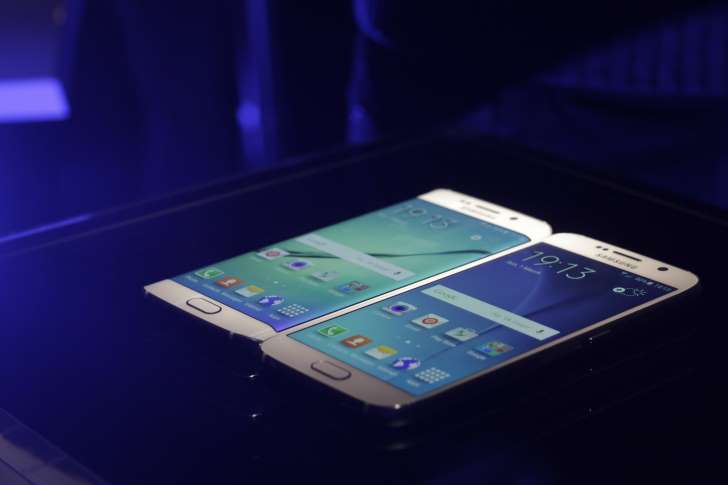August 8, 2015
Samsung’s staring down the barrel of oblivion as it searches for answers to its ever-slipping grip on the mobile market. There’s one week to go before Samsung pins its hopes on the Galaxy Note 5 and Galaxy S6 Edge+: but will it be enough?

Samsung Galaxy S6 & S6 Edge side-by-sde. Image credit: Jay McGregor
August 8, 2015
Samsung’s staring down the barrel of oblivion as it searches for answers to its ever-slipping grip on the mobile market. There’s one week to go before Samsung pins its hopes on the Galaxy Note 5 and Galaxy S6 Edge+: but will it be enough?

Samsung Galaxy S6 & S6 Edge side-by-sde. Image credit: Jay McGregor
The smartphone market has changed dramatically since 2011, when Samsung was the exciting ‘new kid on the block.’ Now, it seems, Samsung’s “Next Big Thing” campaign in 2011, which propelled the company’s Galaxy S2 into the hearts and minds of many Android users looking for an iPhone killer, was the company’s moment in the sun.
It grew from there, hitting higher and higher numbers of sales and profits up until that pesky third quarter in 2013 – when things took a turn for the worse. The tumble in profits continued into 2015, with Samsung confirming last week’s worse-than-expected quarterly results. As the quality of Samsung’s smartphones increased, its profits hit a negative spiral. Its crown has been passed on to new upstarts, like OnePlus and Xiaomi.
Where did it all go wrong? You could point to the poorly received Galaxy S5, some questionable launch adverts and a resurgent Apple. Business Insider’s Steve Kovach also tells a fascinating story about infighting between Samsung’s Korean and US division (which I highly recommend you read), that led to the super successful “Next Big Thing” not being adopted by other territories, and Samsung failing to capitalise on its brief runaway success.
But there’s a bigger problem looming that’s not easily fixed with a company bonding weekend, or a (slightly) more attractive new phablet. The rapid growth of small manufacturers who produce low-cost – high-quality- Android phones. An ever decreasing cost of materials, clever marketing (such as invite-only purchase systems) and turnkey deals have combined to create a nasty thorn in the side of the Android’s biggest behemoths.
Kirt McMaster, CEO of Cyanogen, said back in March that Samsung – and other tier 1 OEMs – will be “slaughtered” in within 5 years because of these new manufacturers. That’s starting to look less like a headline-grabbing, audacious, soundbite and more like a prophecy unfolding before our eyes.
Speaking to Reuters, Ben Thompson, an analyst at Stratechery.com, echoed McMaster’s thoughts. “The writing has long been on the wall for any premium Android maker: as soon as low end hardware became ‘good enough,’ there would be no reason to buy a premium brand,”
Indeed, why buy premium Android when cheap Android is, in fact, just as premium? The final hurdle that kept the premium tier could hold on to was camera quality. But it seems even that awkward barrier has finally been cleared. Motorola just launched two smartphones, which are hundreds of dollars cheaper than Samsung’s flagships, but have comparable cameras. OnePlus has also significantly improved the quality of its rear camera, particularly in low-light scenarios. I suspect we’ll see other, smaller, manufacturers competing in this area in the near future.

Motorola says that the Moto X Style has an edge over the S6 in certain conditions. Image credit: Jay McGregor
This is less of a problem for Apple, because it can offer something entirely different to customers – software. Its recent “there’s nothing quite like an iPhone” campaign capitalises on the notion that Apple isn’t part of the unsightly skirmish taking place over at Android Vendor HQ. Being different, and offering unique services, gives people unique reasons to buy your product – and makes your product unbeatable via emulation. Add in exceptional marketing and a super-loyal fanbase (the Android fan base is more loyal to the OS than the device), and you have a very sturdy position at the top of the market. But even that doesn’t mean it’s immune to the inevitable growth of lower tier vendors: Apple just lost the top spot in China to Xiaomi.
Offering something different is key. Clearly, this is what Samsung has to do if it’s going to elevate itself above the low-cost Android war, as well as challenge Apple for top tier supremacy. It needs more than a slightly curved display, or a nicer-looking Android skin.
Tom Cheesewright, Applied Futurist at Book of The Future, thinks that Samsung’s time in the premium-end of the market is limited. “In the short term you can maintain some differentiation at the top end through premium hardware, as long as the user experience is slick enough to match. Samsung is limited in its ability to define the user experience though, unlike Apple. And its previous attempts at improving the Android UI have had mixed success.
“Without drastically diminishing its range it is never going to achieve the margins this approach demands either, and this would require a radical change in approach (and in its relationships with the operators).”
So what options does it have left? I asked Cheesewright if developing its own OS was the only way to properly differentiate itself from the rest of the Android competition.
“That may mean an alternative to Android as the platform for a future generation of devices, and it has a candidate in Tizen to which it has demonstrated considerable commitment. It may be hard to displace the embedded Android ecosystem in Europe and the US, but the story could be different in Asia. Samsung’s Tizen-based Z1 was its best-selling smartphone in India in the first quarter of this year.”
Developing Tizen into a working, genuinely competitive, mobile OS for the western markets is, at best, a pipe dream. Just take a look at the failed and failing mobile OS alternatives to Android and iOS. But all is not lost. If Tizen became a force in the developing markets, then the excitement and popularity could translate to the West. Xiaomi and OnePlus are perfect examples.
The other option for Samsung is to rapidly develop and release the next jump in hardware technology – foldable displays. This would be something not easily recreated by the smaller OEMs, because the manufacturing requirements could only be met by a big company like Samsung. Check out my dissection of Samsung’s future foldable display plans here.
As Samsung searches for its Next Big Thing, whether it’s a foldable display or rival OS, one thing’s clear – it’s time as a premium Android device maker has been seriously threatened. And without drastic reinvention, the writing could well be on the wall for its mobile division.
Courtesy: Forbes





































































































